Smoked Alaskan Sockeye Salmon and Shrimp Ravioli
You can find farmed salmon almost any time of the year at your grocery store, but whenever you see wild salmon, it’s a special treat.
When I lived in other parts of the country, the price of wild salmon was a little higher than farmed fish, but here on the West Coast it’s the exact opposite.
Today at the grocery store’s seafood counter, farmed Atlantic salmon was $7.99 a pound and right next to it was wild Alaskan Sockeye salmon at $4.99 a pound. Then there was the real deal: Whole wild Sockeye at $2.99 a pound. I prefer the texture and flavor of wild salmon over farmed salmon. Wild salmon have free rein in the ocean and their flesh gets that distinctive color from shrimp and krill in their diet. Farmed salmon live in pens in bays all of their lives and eat a diet of fish chow. To get farmed salmon’s flesh to have color, dye is added to the fish food. That’s why in Oregon you’ll see signs in the fish case indicating that the farmed fish contains artificial colors. The state requires that warning.
I could not believe my eyes when I saw the whole wild Sockeye at $2.99 a pound. Last year, I saw wild Oregon Coho at $3.99 a pound, but this is ridiculous! The Sockeye salmon was glistening silver and it was just calling out to me to take some home. I asked the clerk how much one whole salmon weighed and he assured me it would only be 2-3 lbs. Would he fillet the beast for me, I asked? No problem. I asked him to package the bones separately. My plan was to make another batch of homemade lox with the fillets and use the bones to make some fish stock. Right next to the whole Sockeye was smoked Sockeye from Washington. I took home 6 ounces of smoked Sockeye, as well as 8 large shrimp to make ravioli for dinner.
Ravioli is one of those dishes that you’ll often find in restaurants, and it’s very time-consuming if you’re making the dough from scratch. But here’s a secret: You know those square and round won-ton or dumpling wrappers in the Asian section of the grocery store? Well, you can use them to make ravioli. All you need besides the won-ton wrappers is egg wash, filling and a ravioli cutter.
When I set out to make ravioli, I’ll usually make enough to serve for dinner as well as extra to freeze. After filling the ravioli, you can put them on wax paper and into the freezer and once they’re frozen, just stick them in a Ziploc bag and put them back into the freezer for a simple and easy meal on another day.
It’s also fun to play around with the filling for ravioli. You can use a mixture of cheese and vegetables if you want it to be vegetarian, or fill it with Italian sausage and mushrooms, minced shrimp and pork for a more Asian style, even crab meat. The list is as endless as your imagination. The filling for dinner tonight would be shrimp, smoked Sockeye salmon and leeks.
No slam to the East Coast, but when it comes to salmon there’s more variety on the West Coast. There’s only one variety of salmon in the Atlantic. In the Pacific, there are five main salmon varieties that you’ll see at the grocery store during different times of year: King (also called Chinook), Coho, Sockeye, Pink and Chum (sometimes called Keta). I think the flesh of Sockeye by far has the deepest red coloring. And personally, I think King and Coho are the firmest, which make them stand up to grilling well.
King: The lushest fresh salmon, king is the highest in fat and usually the most expensive, prized for its silken, melting texture, which is almost like smoked salmon.
Chum: Like pink, chum is fished in high numbers and is lower in fat than other varieties; when it spawns in intertidal waters, it doesn’t need to build up energy to swim upstream. Its roe, however, is the most valued of the five varieties, because of its size and flavor. After being strained and separated, the eggs make particularly good ikura— the fat, bright-orange pearls familiar in sushi rolls.
Sockeye: With a deep, natural color, sockeye is lower in fat but still high overall, allowing the flavor to better come through. Many salmon lovers, including me, consider this the best salmon-eating experience.
Coho: A comer, according to Bill Webber and Thea Thomas, independent Cordovan fishermen. It’s already prized by sport fishermen for its fight, and soon, the Cordovans hope, by diners for its mild but distinctive flavor. The most widely available autumn fresh salmon.
Pink: So delicate and pale that Thomas compares it to sole—which she does not mean as a compliment. She recalls a tasting for food writers at which many rated pink the highest. “How could they?” she asks. The likely answer: A lot of these people had never had salmon in their life.
— Corby Kummer, senior editor and curator of the food channel at theAtlantic.com
Smoked Alaskan Sockeye Salmon and Shrimp Ravioli
For the ravioli
Note: this recipe will make about 30 ravioli
- 6 ounces (170 g.) smoked Sockeye salmon
- 8 large shrimp
- Won-ton or dumpling wrappers
- 2 small leeks
- 2 tablespoons (30 ml.) butter
- 2 teaspoons(10 ml.) dry white wine
- 1 egg, beaten (for egg wash)
- Clean the leeks and chop off the green leafy portions; retain only the first 3 or 4 inches that are white. Cut off the roots. Cut the remaining leek stalks lengthwise into quarters and then finely chop.
- In a sauté pan, melt butter over medium heat. Add the chopped leeks and a pinch of salt to season. Sweat the leeks until they start to turn translucent and then add the white wine, stir and turn off heat and let cool.
- Peel shrimp and mince into fine pieces and place into mixing bowl. Set aside the shrimp shells for use in the sauce.
- Cut smoked salmon into fine pieces and added to mixing bowl with shrimp.
- Once the cooked leeks have cooled to room temperature, add to the mixing bowl and mix all ingredients well with your hand, squeezing the shrimp and salmon mixture through your fingers until the mixture turns sticky and the pieces stick together.
- Place about a tablespoon of the mixture in the middle of a won-ton wrapper.
- Brush another won-ton wrapper with some egg wash and place it over the filling and press it gently to form a seal with the other won-ton wrapper.
- Center the ravioli cutter over the won-ton and press firmly to cut the wrappers all the way through.
- Place the finished ravioli on a sheet of wax paper until you’ve filled all of the ravioli. At this point you can freeze a portion for future use by placing them on a sheet of wax paper in the freezer until they’re frozen and then transfer to a Ziploc bag.
For the sauce
- Shrimp shells and/or fish bones
- 4 cups (960 ml.) water
- 1/8 (.5 ml.) teaspoon thyme
- 1/4 (1 ml.) teaspoon salt
- 1 medium carrot, chopped
- 1/4 yellow onion, chopped
- 1 piece of celery, chopped
- 1 cup (240 ml.) heavy cream
- 1/4 cup (60 ml.) dry white wine
- 1 cup (240 ml.) frozen peas
- In a saucepan over high heat, bring the water to a boil.
- Add fish bones or shrimp shells, thyme, salt, celery, onion, carrot and lower heat to simmer for 20 minutes. Strain out fish/shrimp and vegetables and return only the stock to the saucepan and continue to simmer until the stock is reduced by half.
- Reduce heat to low and add cream and white wine and stir briskly until incorporated.
- Simmer over low heat for 10 minutes, stirring every few minutes. Add frozen peas.
- Turn flame to lowest setting to hold warm while you assemble the dish.
Final assembly
- 6-10 mussels
- 1 tablespoon (15 ml.) finely chopped dill
- 1 tablespoon (15 ml.) canola oil
- In a pot, bring water to a boil, add oil, a pinch of salt and drop in the ravioli one at a time, taking care not to crowd the pot.
- Bring pot back to a medium boil, reduce heat to medium and cook the ravioli for 3-4 minutes, turning them over occasionally so they cook evenly.
- As the ravioli are done, place them in the pan with the sauce to keep them from getting cold.
- When all ravioli are cooked, pour out all of the water except for about a quarter of an inch. Bring the water to a high boil and add the mussels to steam them, stirring occasionally until all of the mussels have opened.
- Spoon out the ravioli into a serving bowl. Toss the cooked mussels into the pan containing the sauce and stir to evenly coat the mussels.
- Pour the mussels and sauce on top of the ravioli in the serving bowl.
- Sprinkle the chopped dill over the dish and serve immediately.
This dish would go wonderfully with a pinot gris like the King Estate Pinot Gris or a semi-dry Riesling like the Next Riesling.
Enjoy!
— Vic
Category: Pasta
About the Author (Author Profile)
Victor Panichkul is a journalist and writer by training; a cook, wine lover and photographer by passion; and a lover of the outdoors since moving to Oregon more than 10 years ago. He is a native of Bangkok, Thailand.






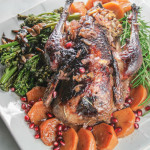
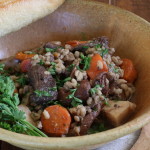
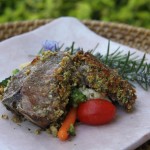

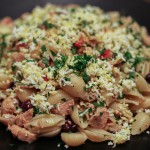
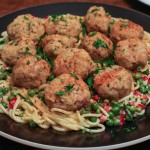
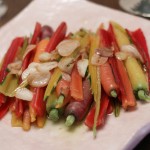
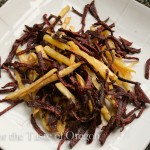

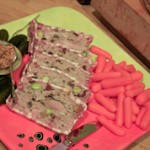
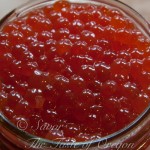
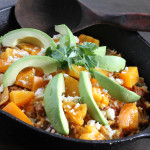
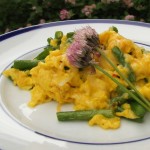
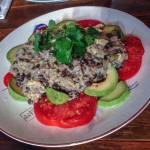
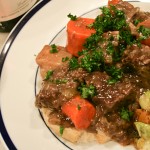
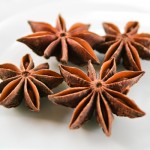
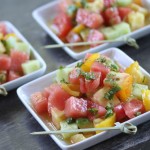
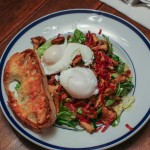
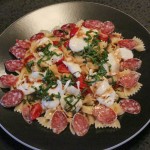
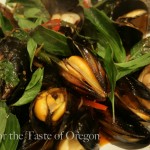
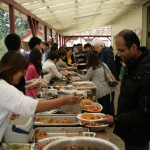
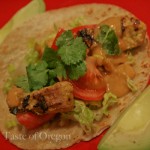
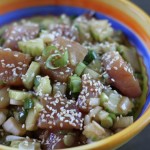
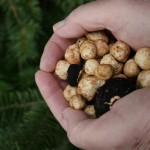
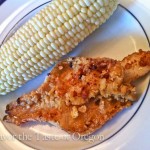

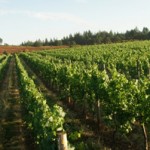
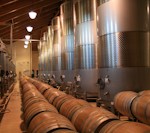
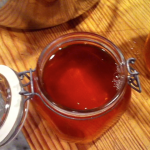





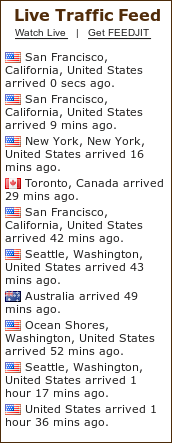





This looks delicious.I may try this recipe but with my own pasta and a light red sauce.
Hi Ed. Thanks for reading and commenting. Please do share your recipe for your red sauce with our readers.
Those are great… wonderful recipe and photos!
wow!this is amazing!!
Looks wonderful and all the ingredients are
what I love:)
I will try this dish ASAP 🙂